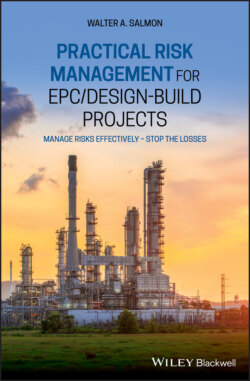Читать книгу Practical Risk Management for EPC / Design-Build Projects - Walter A. Salmon - Страница 24
2.4.4 Standard EPC Contracts Available
ОглавлениеRecognising the vast differences that can occur in respect of an Employer's appetite for accepting risk on large-scale design-and-install/build type Projects, the International Federation of Consulting Engineers (FIDIC) has produced two quite different standard forms of contract for Employers to choose from:
The Yellow Book – ‘Conditions of Contract for Plant & Design-Build’ (2nd Edition, 2017), and
The Silver Book – ‘Conditions of Contract for EPC/Turnkey Projects’ (2nd Edition, 2017).5
In only one of the above two FIDIC publications is the term ‘EPC’ applied (in the Silver Book). However, the FIDIC Yellow Book (2017) is also clearly a contract suitable for an EPC Project, since the requirement therein is also for the Contractor to complete the Engineering work as well as undertake all the Procurement and Construction activities, as is shown by its subtitle (‘For Electrical & Mechanical Plant, And For Building And Engineering Works, Designed By The Contractor’). Although there is a large degree of similarity between the two sets of FIDIC design-and-install/build type contractual arrangements, one of the principal differences is that the Yellow Book shares the responsibilities and liabilities inherent in the major implementation risks more evenly between the two parties (and also the consequent apportionment of cost sharing for dealing with those risks). By contrast, the Silver Book requires the Contractor to bear nearly all the risks entirely at its own expense, regardless of what those risks are or how onerous they are.
Another interesting thing to note is that the participants acting for the Employer are quite different between the FIDIC Yellow and Silver Books. In the Yellow Book it mentions the Engineer, while in the Silver Book there is only an Employer's representative (whose role is markedly dissimilar from the Engineer mentioned in the Yellow Book). The difference between the Yellow and Silver Books is primarily a result of the ‘turnkey’ arrangement catered for under the Silver Book, where the Contractor is expected to operate far more independently of the Employer and accept a far greater risk burden than is envisaged under the Yellow Book. Under the ‘turnkey’ arrangement, FIDIC expects the Employer to do nothing much more than (i) not hinder the Contractor in its implementation efforts, (ii) pay the Contractor in accordance with the contractual provisions, and (iii) wait to be handed the keys of the fully completed facility. Further, FIDIC appears to use the term ‘turnkey’ in the Silver Book to refer to the situation where the Employer passes over virtually every conceivable risk to the Contractor in anticipation of not paying extra for any eventualities or extra work subsequently found to be required. That arrangement is significantly different to the situation where risks are spread more evenly between the Employer and the Contractor (on the basis, say, of looking to see which party is better suited to averting/handling any given risk item), as they are under the FIDIC Yellow Book.
Where the EPC Contractor is required to take full responsibility for handing over the facility in the required time-frame based on the premise that no changes to the Employer's requirements will be evidenced, the contract is sometimes referred to as being Lump-Sum Turnkey in nature (‘LSTK’ being the abbreviation/initialism commonly used for that term). Under an LSTK Contract, the Employer will generally expect no extra costs to be payable to the Contractor for completing the work specified in the contract. It should be noted that all LSTK Projects are EPC Projects, but not all EPC Projects are LSTK contracts.
The choice by the Employer as to which of the above FIDIC-orientated EPC/Design-Build contractual arrangements should be adopted will depend to a great extent on the following factors:
1 what type of organisation the Employer has and, therefore, on just how much (or how little) technical competence sits within the Employer's organisation,
2 how much control the Employer wishes to exercise over the implementation process, and
3 the price the Employer is willing to pay to pass as much as possible of the implementation risks over to the Contractor.
Some Employers prefer to adopt the equivalent of the FIDIC Yellow Book approach for EPC Projects (where an Engineer is appointed separately to represent the Employer). The Yellow Book approach is very often selected where the Employer has a competent in-house workforce to handle the supervision of the implementation activities, especially the on-site work. The alternative approach is to follow more closely the FIDIC Silver Book provisions. This is usually done where the Employer does not have adequate resources to supervise the whole of the implementation work. No separate Engineer is appointed under this alternative approach but, instead, only a representative of the Employer, whose role will be to interface with the EPC contractor (although very often subject to strict limitations of authority). Having said that, the Employer may nonetheless appoint separate companies to monitor either the engineering activities, the procurement activities, the construction activities and/or the commissioning work activities, or any combination of such monitoring activities; there are many possibilities/options available.
